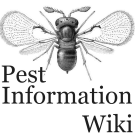Publications for:
pest = Plutella xylostella
beneficial = Beauveria bassiana (entomopathogen)
found 22 publications:2019
Beauveria bassiana (Ascomycota: Hypocreales)–treated diamondback moth (Lepidoptera: Plutellidae) larvae mediate the preference and functional response of Euborellia annulipes (Dermaptera: Anisolabididae) nymphsJournal of Economic Entomology (2019) 112 (6), 2614-2619
publishers website - pestinfo wiki
2016
Potential of entomopathogenic fungi as biological control agents of diamondback moth (Lepidoptera: Plutellidae) and compatibility with chemical insecticidesJournal of Economic Entomology (2016) 109 (2), 594-601
publishers website - pestinfo wiki
2013
A fungal insecticide engineered for fast per os killing of caterpillars has high field efficacy and safety in full-season control of cabbage insect pestsApplied and Environmental Microbiology (2013) 79 (20), 6452-6458
publishers website - pestinfo wiki
2012
Seleção de isolados de Beauveria bassiana potenciais para o controle da traça-das-crucíferas[Selection of Beauveria bassiana isolates potential for diamondback moth control]
Horticultura Brasileira (2012) 30 (3), 391-396
publishers website - pestinfo wiki
2011
Associação do óleo de mamona com Beauveria bassiana no controle da traça-das-crucíferas[Association of castor bean oil with Beauveria bassiana for diamondback moth control]
Pesquisa Agropecuária Brasileira (2011) 46 (2), 212-214
publishers website - pestinfo wiki
2010
Farmer field school-IPM impacts on urban and peri-urban vegetable producers in Cotonou, BeninInternational Journal of Tropical Insect Science (2010) 30 (1), 19-31
publishers website - pestinfo wiki
2008
Evaluating biological based insecticides for managing diamondback moth, Plutella xylostella (L.) (Lepidoptera: Plutellidae)Journal of Entomology (2008) 5 (4), 252-261
publishers website - pestinfo wiki
2007
Cultivable bacteria associated with larval gut of prothiofos-resistant, prothiofos-susceptible and field-caught populations of diamondback moth, Plutella xylostella and their potential for, antagonism towards entomopathogenic fungi and host insect nutritionJournal of Applied Microbiology (2007) 103 (6), 2664-2675
publishers website - pestinfo wiki
2006
Variation in virulence of Beauveria bassiana isolates and its relatedness to some morphological characteristicsBiocontrol Science and Technology (2006) 16 (5), 525-534
publishers website - pestinfo wiki
Interação de Metarhizium anisopliae (Metsch.) Sorok., Beauveria bassiana (Bals.) Vuill. e o parasitóide Oomyzus sokolowskii (Kurdjumov) (Hymenoptera: Eulophidae) sobre larvas da traça-das-crucíferas, Plutella xylostella (L.) (Lepidoptera: Plutellidae)
[Interaction of Metarhizium anisopliae (Metsch.) Sorok., Beauveria bassiana (Bals.) Vuill. and the parasitoid Oomyzus sokolowskii (Kurdjumov) (Hymenoptera: Eulophidae) with larvae of diamondback moth, Plutella xylostella (L.) (Lepidoptera: Plutellidae)]
Neotropical Entomology (2006) 35 (2), 241-245
publishers website - pestinfo wiki
Evaluation of the time-concentration-mortality responses of Plutella xylostella larvae to the interaction of Beauveria bassiana with a nereistoxin analogue insecticide
Pest Management Science (2006) 62 (1), 69-76
publishers website - pestinfo wiki
Biological characterization of Beauveria bassiana isolates from Taiwan
Plant Protection Bulletin (Taipei) (2006) 48 (2), 117-128
pestinfo wiki
2005
Biological control of the diamondback moth, Plutella xylostella: A reviewBiocontrol Science and Technology (2005) 15 (8), 763-789
publishers website - pestinfo wiki
2004
Initiation of fungal epizootics in diamondback moth populations within a large field cage: proof of concept for auto-disseminationEntomologia Experimentalis et Applicata (2004) 111 (1), 7-17
publishers website - pestinfo wiki
2003
Suscetibilidade de Plutella xylostella (L.) (Lepidoptera: Plutellidae) aos Fungos Beauveria bassiana (Bals.) Vuill. e Metarhizium anisopliae (Metsch.) Sorok[Susceptibility of Plutella xylostella (L.) (Lepidoptera: Plutellidae) to the fungi Beauveria bassiana (Bals.) Vuill. and Metarhizium anisopliae (Metsch.) Sorok]
Neotropical Entomology (2003) 32 (4), 653-658
publishers website - pestinfo wiki
Susceptibilidad de Plutella xylostella (Lepidoptera: Iponomeutidae) a diferentes aislamientos nativos de Beauveria bassiana y su efecto adicional sobre otros lepidópteros asociados a la coliflor
[Plutella xylostella susceptibility to different native isolates of Beauveria bassiana and additional effect to other cauliflower Lepidoptera]
Revista Colombiana de Entomología (2003) 29 (2), 211-219
pestinfo wiki
2000
[Microbial control of the diamondback moth, Plutella xylostella, by an entomopathogenic fungus, Beauveria bassiana. II. Effects of temperature on mycoses and conidial invasion time]Japanese Journal of Applied Entomology and Zoology (2000) 44 (3), 177-182
publishers website - pestinfo wiki
1999
Potential of the entomopathogenic fungus, Beauveria bassiana strain CS-1 as a biological control agent of Plutella xylostella (Lep.,Yponameutidae)Journal of Applied Entomology - Zeitschrift für angewandte Entomologie (1999) 123 (7), 423-425
publishers website - pestinfo wiki
1998
Dose-response and age- and temperature-related susceptibility of the diamondback moth (Lepidoptera : Plutellidae) to two isolates of Beauveria bassiana (Hyphomycetes : Moniliaceae)Environmental Entomology (1998) 27 (4), 1017-1021
pestinfo wiki
[Microbial control of Diamondback Moth, Plutella xylostella, by entomopathogenic fungus, Beauveria bassiana. I. Laboratory studies on pathogenicity of Beauveria bassiana and field experiment]
Japanese Journal of Applied Entomology and Zoology (1998) 42 (2), 51-58
publishers website - pestinfo wiki
Assessment of Beauveria bassiana sprays for control of diamondback moth (Lepidoptera: Plutellidae) on crucifers
Journal of Economic Entomology (1998) 91 (3), 624-630
pestinfo wiki
Efficacy and persistence of Beauveria bassiana and other fungi for control of diamondback moth (Lepidoptera : Plutellidae) on cabbage seedlings
Journal of Entomological Science (1998) 33 (2), 142-151
pestinfo wiki
